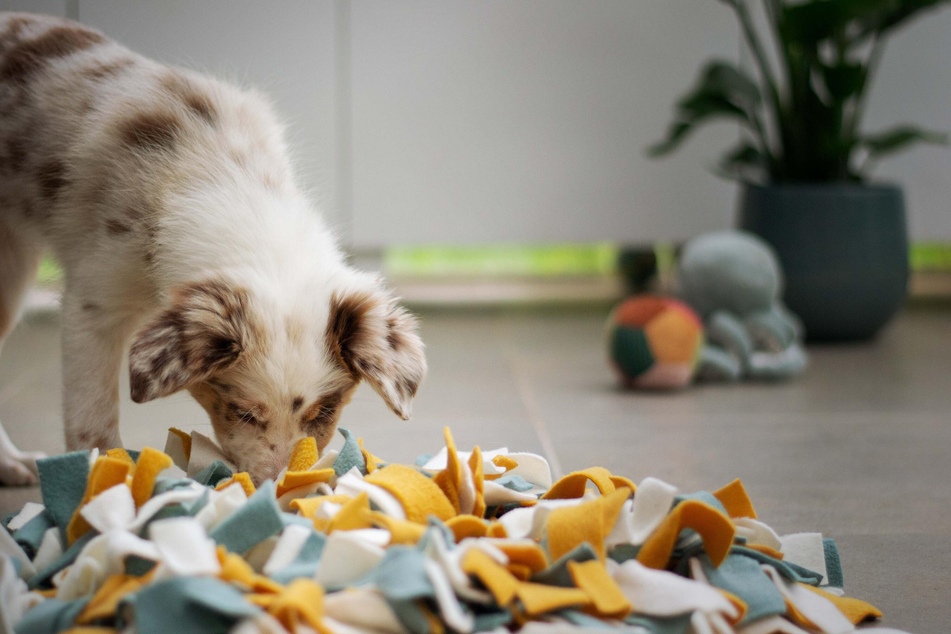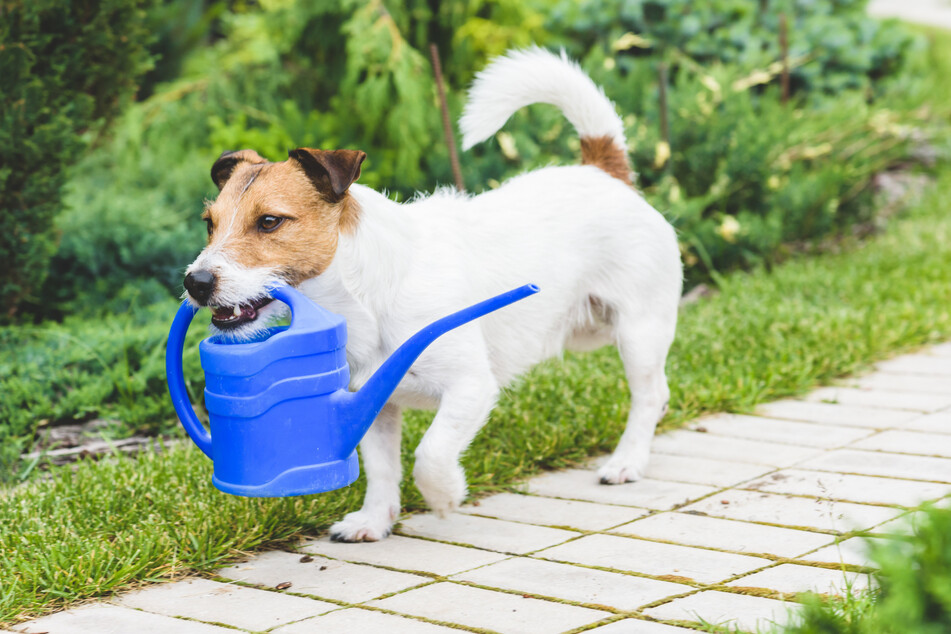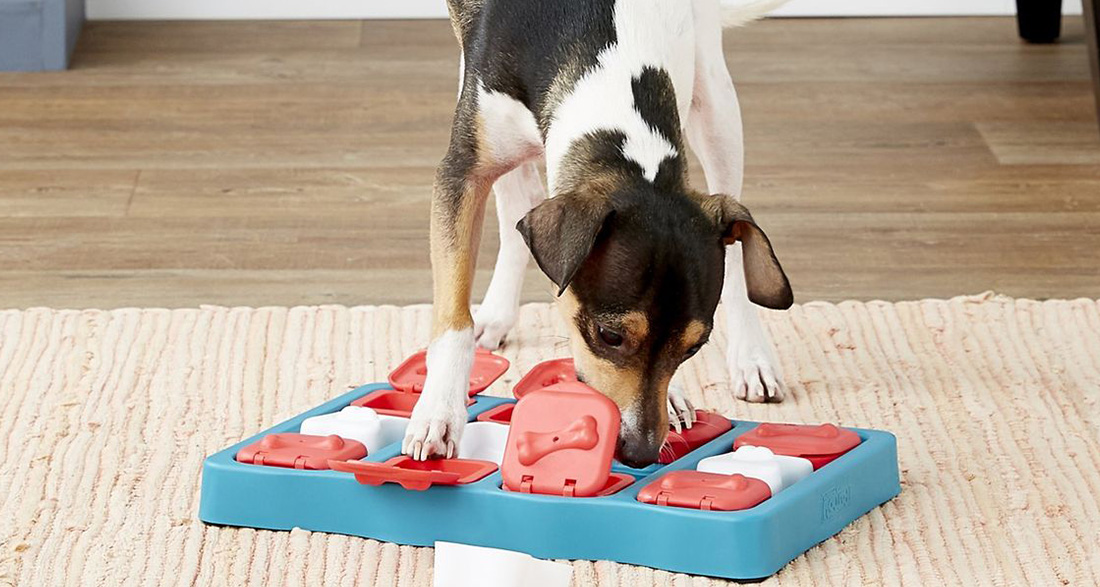Mental exercises for dogs indoors: Puzzle games for dogs are fun and keep your furry friend’s brain active. This includes search games that sharpen the animal’s senses. iHugDogs presents five great ideas that will not only entertain your dog but also promote cognitive development.
- Puzzle games: an essential activity for dogs
- 4 Tips to Ensure Puzzle Games Don’t Burden Your Dog
- Search and Puzzle Games for Dogs – 5 Tips
- Hide and Seek with Your Dog
- Intelligence Game for Dogs: The Cup Game
- Playfully Fishing for Dog Treats
- Fetch Games for Your Dog
- Not in the mood to create brain games for dogs yourself?
Puzzle games: an essential activity for dogs
If you want to engage your dog, you should consider not only physical activity but also games that train its mind and senses.
Exploring, searching, puzzling, and finally experiencing the joy of solving a puzzle – this is not only enjoyable for many people. Go ahead and let your furry friend engage its brain and solve puzzles.
Because puzzle games for dogs are not just a good way to keep them occupied; they promote mental fitness and well-being when designed correctly. A challenging intelligence game with a subsequent reward adds variety and can make your dog happy and confident. Moreover, you can easily entertain your pet indoors with puzzle games.
Of course, there are a few things to consider to avoid frustrating or overstimulating the dog. This guide provides four tips to prevent that and introduces five puzzle games for dogs at home.
Quick Tips for Readers:
- Puzzle games are a great activity that can be enjoyable and enhance cognitive fitness.
- You can introduce different stimuli, including sight, sound, and smell, to promote your dog’s thinking.
- Avoid overwhelming the dog, gradually increase difficulty, and stop before the dog is completely exhausted.
- Use consistent commands for puzzle games, so the dog knows what to do and associates actions with commands.
4 Tips to Ensure Puzzle Games Don’t Burden Your Dog
Before you enthusiastically start, here are a few tips to ensure the games don’t lead to frustration for your dog:
- Tip 1: Don’t Make the Task Too Difficult! Exercising your dog’s mind? Of course, the puzzle game should challenge your dog but not overwhelm it! Start with very easy tasks and gradually increase the difficulty. For search and sniffing games, you can initially place the treat or the object to be found visibly for the dog and consistently use the same words and commands. This way, your sweetie learns how the game works.
- Tip 2: Don’t Play for Too Long! Animals get tired after dealing with tricky tasks for a while. It requires a lot of empathy because every dog is different, and fatigue varies. If you notice disinterest, fatigue, or overstimulation, end the game – ideally with a sense of accomplishment. Plan the end of the game in advance and don’t wait until the dog shows signs of fatigue. Just a few minutes a day are often enough to entertain the dog.
- Tip 3: Indicate the Beginning and End! Your dog should not think there are treats to be found anywhere in the house or the entire time. To avoid this, come up with two words that you always use to start and finish the game. These can be simple designations like the name of the game at the start and “game stop” to end it. An associated, clearly understandable hand signal that you only use in this context can support the start and stop signals.
- Tip 4: Don’t Give Too Many Treats! Even though treats are a wonderful motivator and learning aid, be mindful of your dog’s nutrition and weight. It’s not just about the calories; treats stimulate appetite and salivation and influence insulin levels. Therefore, try to use alternative rewards like petting or its favorite toy as often as possible.
Search and Puzzle Games for Dogs – 5 Tips
Puzzle games are a great way to combine fun and learning. You don’t need much equipment; everyday items and a bit of creativity are usually sufficient to bring variety to your dog’s routine. Here are a few ideas:

Sniffing Games for Dogs – Achieving the Goal with Nose Work
To foster your dog, it’s essential to sharpen and train its senses. And which sense stands out in dogs? Obviously, the sense of smell.
Searching for treats:
The simplest version: Hide treats for the dog to sniff out, for example, under a pillow, behind a flower pot, etc. If you’re crafty, you can create a fantastic sniffing game from wood, cardboard, or fabric scraps. You can let your creativity run wild – the main idea is to have different compartments or sections where you can place treats for the dog to sniff out. Besides various boxes, sniffing mats are popular, simulating the search for something in the grass. Fabric pieces are sewn onto a base, between which you can place the reward.
Searching for objects:
Is your dog trained enough to know names for specific objects? You can hide and let it search for them (e.g., “Find your stuffed animal!”).
If you have the opportunity to set up an exciting sniffing game outdoors, and your dog is familiar with the game, you can also train its sense of smell over longer distances.
Tip
Teaching your dog names for objects can also be an excellent puzzle game.
Hide and Seek with Your Dog
Hide and seek is not just for children; it can also be a lot of fun for dogs and help sharpen their senses.
Owner or caretaker searching:
Here’s how:
- Command your dog to wait in a specific location (e.g., “Place!” or “Sit!”).
- Now, hide in another room, under a blanket, or behind a curtain. This shouldn’t take too long.
- Give a command for your dog to come to you (e.g., “Come!” or “Search!”).
- If he doesn’t find you, help him by making sounds.
- Once he finds you, immediately reward him with a small treat (you should already have it in your hand, so he associates the reward with finding you) or praise and a petting session.
Important
Don’t overdo the hide and seek game! Your pet shouldn’t develop separation anxiety. Hide nearby, ensuring the dog can find you after a short time.
Intelligence Game for Dogs: The Cup Game
You can engage your dog’s sense of smell and abstract thinking simultaneously with the cup game.
Here’s how:
- Grab cups, small buckets, or similar containers that are not too shallow, so the dog can easily knock them over.
- Place a treat under one cup and switch the cups’ positions by sliding them.
- Ask, “Where is the treat?” to encourage the dog to find the correct cup hiding the reward.
- The dog touches the cup with his paw or knocks it over with his snout (depending on the skills he has learned).
Initially, demonstrate this thinking game with just one cup and play it out once so that he understands how it works.
The difficulty level can gradually increase by adding more cups (don’t exaggerate! Three to four cups are sufficient).
Playfully Fishing for Dog Treats
In this game, the sense of smell is essential, along with a certain level of motor skills, as the goal is to have the animal fish out small treats from a box.
- For small dogs, an ice cube tray works well.
- For larger dogs, a muffin tin can be filled.
- Alternatively, you can craft a cardboard box with multiple compartments and lids.
Here’s how:
Place a reward in some compartments and cover them with a lid, such as a piece of cardboard (large enough so he can’t easily swallow it). The four-legged friend must sniff out the reward and push the lid aside to access the treat.
Fetch Games for Your Dog

Many dogs enjoy retrieving things. Turning fetching or carrying items into a game can keep the dog entertained. Similar to humans, dogs also feel valuable (albeit not consciously) when they have a task and receive a reward for fulfilling it – even if it’s just a small pat.
If the dog already knows the names of specific objects, you can command him to fetch and bring those items. A classic example is fetching the newspaper, ideally in a way that it remains readable.
Other items, like a watering can for gardening, can also engage the dog actively in family activities.
If he hasn’t mastered this yet, start by giving him items and teaching him to bring them to a specific location. For instance, give him a worn, lightweight piece of clothing with the command “Take!” Go to the washing machine together, place your hand inside, and command “Drop!” If he places the clothing in the machine or at least right in front of it, praise him. Gradually, using commands, teach him how to complete the task independently.
Not in the mood to create brain games for dogs yourself?
Playing with your dog not only promotes their intelligence but also strengthens the bond between you two. If you have no interest in crafting, hiding, or being active, you can always buy intelligence games for dogs.
Various options are available, such as wooden boxes or boards where the dog must open different compartments to reach the reward, treat balls, and similar search games that challenge and stimulate them. Snuffle mats, as described earlier, come in various forms and colors in the market.
Important: Not everything on the market is suitable for your dog. Ensure that the intelligence games are made from high-quality materials that are not harmful and cannot injure the animal (such as splintering wood).
Conclusion
Thinking games that involve a dog’s sense of smell, sight, and understanding of connections are essential for mental health. Additionally, playing together strengthens the bond with your pet.
Regardless of the game you choose, it’s crucial to proceed step by step, use consistent commands, and avoid overwhelming your dog.
And if making brain games for dogs isn’t your thing, no problem! There are fantastic options available for purchase.


